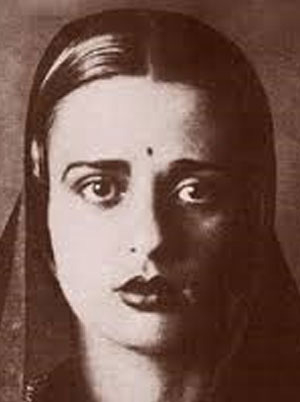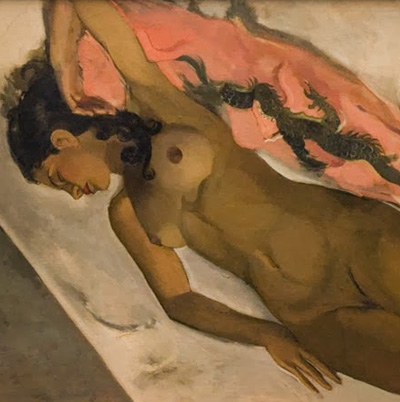The film is a passionate and sweeping romance. Positioned as a cross over film, it tells the poignant and heart rending story of a young woman – Amrita Sher Gill- who wants to live life on her own terms. Set in the 1920’s and 1930’s it narrates the dilemma of a woman whose views and moral positions are way ahead of her times. The tempestuous story of an artist who tries to find her own voice - her own vision unwilling to be a conformist.
Amrita Sher Gill is born of Hungarian mother and an Indian (Sikh) father. She refuses to accommodate herself to the norms of traditional society. Amrita has many relationships but finds unconditional love only with her first cousin Victor Egan - a childhood friend and companion- who grows up to become her closest confidante - her husband - but ironically - at the very end – perhaps the reason for her premature death at a young age of 28.
The story is set in Europe and India and moves between these two geographical and cultural areas- as the protagonists also locate themselves in Budapest, Paris (Europe) and Simla and Lahore (then art capital of undivided India). The two World Wars become the book ends within which the story is told- and tragedy from these events preoccupy and motivate the protagonists in the film.
The story begins with AMRITA very ill- almost in her death bed. it then shifts to the time before her death, when she and VICTOR are married and when Amrita falls ill. The story then moves to the beginning where the child Amrita and her cousin Victor are growing up in Hungary in the 1920's. It is clear that, already from this young age, Victor dotes on Amrita. From then on the story is told in a chronological manner till the end.
Amrita's father, UMRAO, is a Sikh nobleman. Her mother, MARIE ANTOINETTE, Hungarian opera singer whose emotional outbursts seem to be the root cause of her tempestuous marriage. Amrita also has a sister, INDIRA, who is learning classical music. Because of the World War 1, Umrao is prevented from leaving Hungary - and from receiving funds from India. When Hungary declares a truce, the family leaves for India. Amrita is parted from Victor but they continue to stay in touch through their letters, and it is clear there is still a strong bond between them. They are very different from each other: Victor wants to become a doctor and says that he lacks imagination, while Amrita engulfs herself in an imaginary world, painting heroines from Carmen to the Queen of Sheba.
In India, Marie Antoinette models and falls in love with an Italian sculptor, MARIO. At Marie Antoinette's request, Mario teaches Amrita sculpture - even though it is painting that Amrita wants to master. Amrita's uncle Baktay encourages her to draw from real life; to use live models. Marie Antoinette feels Amrita needs to be reacquainted with European culture and so takes the girls to be schooled in a convent in Italy - although Marie Antoinette really wants to re-connect with her lover, Mario. However, Marie Antoinette discovers that Mario has gone back to his wife. In Italy, Amrita begins to draw live models - most notably a young, naked Italian schoolgirl. This does not go down well with the Mother Superior who expels Amrita from the convent. But the family realizes that Amrita has huge artistic talent - so they all move to Paris where Amrita studies painting. Here she befriends her classmates a young woman, Marie Louise, and a young man, Boris. They become her models - and her lovers. Amrita wins a prize for her portrait of Boris. Ironically when Victor's friend EDITH comes to Paris, she too becomes Amrita’s lover. This is the bohemian Paris of the late 1920’s.
Amrita and her family return to Hungary for holidays. Amrita shares everything with Victor, telling him that she can give her body to strangers, but can only give her secrets to him. Victor is training to be a doctor and finds it hard to hear Amrita's stories as he is still very much in love with her. In Paris Amrita meets YUSUF - a rich, young, Indian of noble origins. She and Yusuf soon get engaged, much to Marie Antoinette's delight (she wants her daughter to have a rich husband). But Yusuf drinks a lot and is a philanderer by nature.
One day, Amrita finds him in bed with a prostitute. Amrita does not tell Victor of her engagement to Yusuf, but when she returns to Hungary, Amrita does ask Victor to examine her. He tells her she is pregnant with Yusuf's child. Victor performs an abortion and Amrita tells him that he is saving her - both as a painter and as a woman. She breaks off her engagement with Yusuf.. She also feels by now that her art is derivative- so she decides to go back to India to find her own artistic voice and vision…
In India, Amrita continues with her individual lifestyle although now Amrita becomes disdainful of lovers after she has had sex with them. She has a torrid love affair with MALCOLM MUGGERIDGE, an English journalist. In the meantime, Indira (Amrita’s younger sister) gets married.
Amrita’s increasing recognition as an artist prompts her to now look for love and although she has many affairs - she eventually decides to get married to Victor – much against the wishes of her parents. So she leaves for Hungary all by herself. Victor is given leave from the medical corps on the Czech border for the wedding. But when she reaches Budapest Amrita finds that she is pregnant. Victor accepts her for what she is but this time, Amrita has a miscarriage.
Then, before 2nd World War breaks out, Victor and Amrita hurriedly leave for India. They stay with Amrita's mother, who still opposes their marriage. Amrita and Victor move to a sugar plantation in North India, Saraya, where Victor works as a doctor - although for a pittance.
They finally decide to move to Lahore - the art capital of undivided India. Amrita is pregnant, Victor performs another abortion on her, but something goes horribly wrong. A consultant is called in. The consultant says it is too late; there is nothing he can do.. Amrita dies at a young age of 28. - Marie Antoinette believes that Victor is responsible for her death.
Shot stylishly with the colours inspired by the frames and paintings of Amrita. Music will be an integral part of the narrative.
It will be shot mainly in Hungary and India. Even scenes of Paris will be recreated in Hungary/Prague.
It will be directed by National and International Award winning film –maker Ramesh Sharma - who won the Karlovy Vary Film Festival award for his feature film New Delhi Times - who's film the feature documentary The Journalist and The Jihadi - The Murder of Daniel Pearl, which was co-produced with HBO and was nominated this year for two Emmy awards in the USA. His latest film AHIMSA- Gandhi: The Power of the Powerless is ready for International Distribution.
We intend to work with well-known actors from UK and Europe in the lead roles - but we will audition for a fresh young face ( either Spanish, Italian or Asian girl with dark hair) to play the role of Amrita.
The technicians will be mainly from Hungary/Europe and India. We hope to do the post production in Budapest/Prague/India - unless of course dictated by the investments we get.
← Back to Projects

